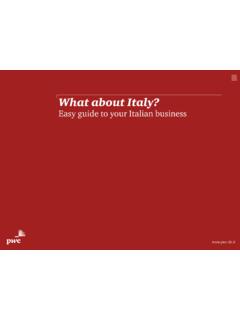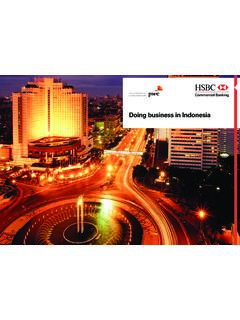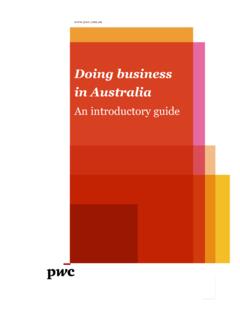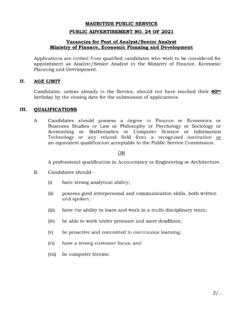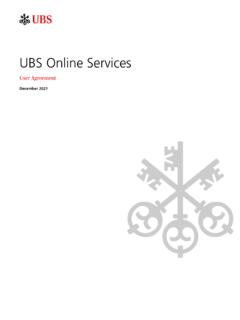Transcription of Success factors in post-merger integration - PwC
1 Success factors in post -merger integrationDeal makers share their recipes for successPwC s M&A integration Survey Report 2017 Entering foreign markets and reaching new customers, increasing market share and extending product portfolio, realising cost savings or acquiring key talent the rationale for mergers and acquisitions (M&A) vary from deal to deal. Nevertheless, all acquisitions share a common objective: the acquirer expects to add value and realise synergies so that the combined business is greater than just the sum of its parts. Buying a company is a vital growth strategy and carries with it high , two out of three acquisitions destroy value rather than create it.
2 What are the reasons some deals are sustainably successful while others fail to meet expectations? What are the typical challenges acquirers face? Our experience shows that the main reason for failure is poor performance during post -merger integration (PMI). PMI is key to every deal and a crucial factor in whether a transaction adds value or not. In order to understand the value drivers in a PMI process, we conducted a survey among top managers and M&A experts. We gathered information on how businesses perform throughout the integration process. In order to shed light on the main Success factors we split respondents into two groups: deal makers who are able to reach their return on investment (ROI) expectations and deal makers who fail to meet ROI targets.
3 We analyse their responses separately in order to highlight possible sources of Success and failure. Throughout the study, we show what successful deal makers do particularly well compared to less successful acquirers with the goal to identify practical insights for our clients. We would like to thank all survey participants for their contributions. Their answers enabled us to gain valuable insights into the challenges of M&A integration , develop credible findings and give a consolidated view on the present M&A integration hope you find the survey results insightful and Claude FuhrerDr. Rosi LiemDenise ZwaldYour M&A integration Survey teamPrefaceContentsList of figures.
4 5 About this survey ..6 Executive summary ..8 ROI differentiating successful vs unsuccessful deal makers ..10 Survey conclusions and recommendations ..12 Detailed results along four Success factors ..141. Synergies ..142. Speed of integration ..203. Culture and change management ..244. Project governance ..32 Authors and contacts ..38 List of figuresFigure 1 About the survey and the respondents ..7 Figure 2 Result structure is divided along the four identified Success factors ..9 Figure 3 Successful vs unsuccessful deal makers ..12 Figure 4 Summary of the four Success factors and their impact on ROI achievement.
5 13 Figure 5 Synergy targets achieved ..14 Figure 6 Please indicate the integration depth of the respective business functions Percentage of answers Full integration ..15 Figure 7 Please indicate the integration depth of the respective business functions Percentage of answers Full integration and Partial integration ..16 Figure 8 Please indicate the three functions in which you achieved the highest synergies ..17 Figure 9 Please indicate the integration depth of the respective business functions Percentage of answers Full integration ..17 Figure 10 Did you define and employ figures for performance measurement (KPIs) to track synergy realisation?
6 18 Figure 11 Completion of PMI project within defined time frame ..20 Figure 12 How long did it take to complete the integration of the respective business functions? ..21 Figure 13 Please indicate the integration depth of IT ..22 Figure 14 Percentage of those, who completed integrating IT within two years after closing ..22 Figure 15 How fast was your integration compared to your initial timeline? Percentage of answers Slower ..23 Figure 16 Well received culture and change management ..24 Figure 17 In which areas did risks actually materialise? Percentage of answers Actually materialised ..25 Figure 18 Did you consider the cultural fit of your organisation?
7 Percentage of answers Yes, absolutely and Yes, to a larger extent ..26 Figure 19 Did you define and employ figures for performance measurement (KPIs) to track the Success of your cultural integration ? ..26 Figure 20 Please indicate which attributes applied to your change management approach and execution Percentage of answers Yes, absolutely and Yes, to a larger extent ..27 Figure 21 Which change management activities contributed most to your deal Success ? Please write down your most successful change management activities ..29 Figure 22 Were your expectations achieved in regard to the following dimensions?
8 Share of respondents, who achieved/overachieved expectations ..30 Figure 23 How fast was your integration compared to your initial timeline? ..31 Figure 24 Strong project governance implemented ..32 Figure 25 Did the following properties apply to your integration setup? Percentage of answers Yes, absolutely and Yes, to a larger extent ..33 Figure 26 Did you identify and manage risks proactively? ..34 Figure 27 In which areas did risks materialise? Percentage of answers Issues actually materialised ..34 Figure 28 Did you complete the PMI as initially planned/slower/quicker? Percentage of answers As planned and Quicker.
9 35 Figure 29 Did you achieve expectations with regard to cultural integration ? Percentage of answers Yes, absolutely and Yes, to a larger extent ..36 Success factors in post -merger integration5 IndustriesWas the deal target a standalone company or carved out part of a larger entity?Employees Success factors in post -merger integration is the latest PwC study exploring deal makers recipes for suc-cessful M&A integrations. More than 50 company representatives took part in the survey. The results reflect the experiences from over 260 deals con-ducted in the past three years by the participating vast majority of respondents are members of the management board or are at executive level as head of M&A, strategy or finance .
10 Half of the partici-pating companies have completed five or more acquisitions within the last three years. The respondents covered a broad section of industries with 22 % in industrial products and 20 % in the technology sectors. We interviewed smaller firms with up to 2,500 employees as well as large organisations with more than 50,000 employees. In almost three quarters of the acquisitions considered, the target was a stand-alone company; in the remaining cases, acquirers purchased a carve-out 1 About the survey and the respondents37 %Head of M&A27 %Management Board Member12%Head of Strategy 12 %PMI ManagerParticipants>50 Deals covered>260 About this surveyHow many M&A buy-side transactions did your company close in the course of the past three years?







